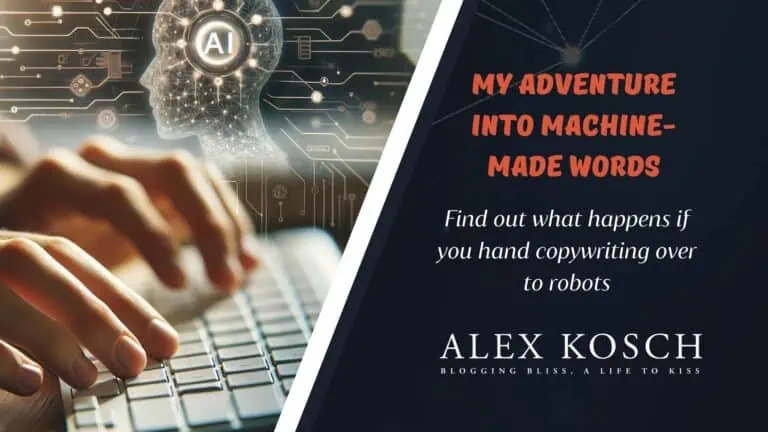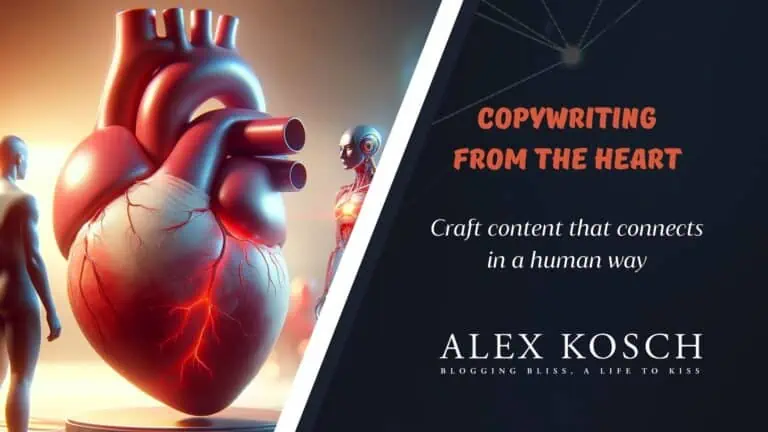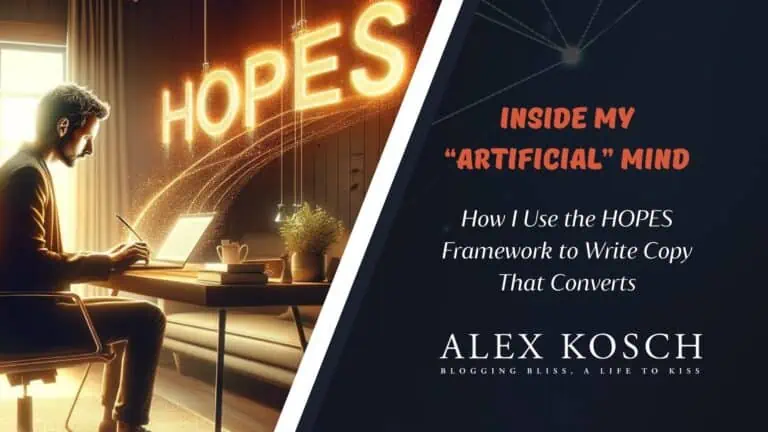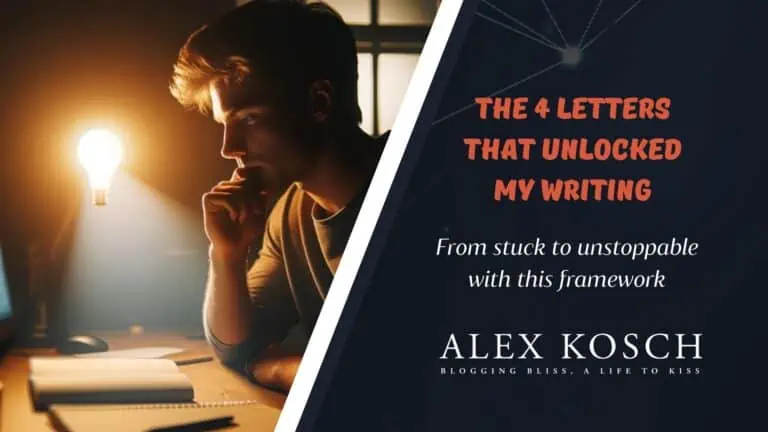
I still remember the first time I tried to write copy. I stared at the blank page for hours, racking my brain for the “perfect” words that would magically convince people to buy. The result? A jumbled mess of rambling text that couldn’t sell ice water in the Sahara.
If you’re struggling to write high-converting copy, I’ve been there. The blank page is daunting, and it’s hard to know where to start. But once I discovered the DEEP copywriting framework, my copy went from zero to hero practically overnight.
This simple yet powerful framework transformed my copy in 4 key ways:
The result? Copy that just plain works. If you want to tap into the full potential of this copywriting framework, read on. In this comprehensive guide, we’ll cover:
- What the DEEP framework is and how it works
- Real-world examples of the DEEP framework in action
- Tips to optimize each element of the framework
- How to combine DEEP with other copywriting frameworks
- FAQs and a custom prompt to generate DEEP copy with AI
Let’s dive in and take your copy to the next level!
What Is the DEEP Copywriting Framework?

The DEEP framework is a copywriting technique focused on four core elements:
By focusing copy on these four elements, the DEEP framework helps uncover the deepest insights about an audience. You can then craft copy that aligns with their internal world — words that truly click.
For example, someone may desire confidence, which triggers emotions like hope and pride. They likely expect to feel self-assured and respected. But they have the pain point of social anxiety holding them back. DEEP copy would tap into all four layers to connect and compel.
The framework works especially well for marketing high-consideration or emotional purchases. But it can benefit any copy aimed at internal motivations and transformations.
Let’s look at some real-world examples of how to apply the DEEP technique.
Real-World Examples of the DEEP Copywriting Framework
To see the DEEP framework in action, let’s walk through some copywriting examples across different niches:
Example 1: Life Coaching
Desires: Self-fulfillment, achievement, confidence
Emotions: Excitement, empowerment
Expectations: Greater success, work-life balance, feeling actualized
Pain points: Feeling stuck, dissatisfaction, lack of purpose
You’ve achieved outward success, but something is missing. You long for a life of deeper fulfillment and meaning. One where each day fills you with purpose. Your time and energy go towards what matters most. But old habits, limiting beliefs, and distractions stand in the way of the breakthrough you crave. It’s time to shatter your glass ceilings. Our [6-month coaching program] helps ambitious, driven professionals like you optimize performance, actualize potential, and design a life you love. You’ll gain unshakeable confidence and life-changing focus. Say goodbye to distraction and dissatisfaction. Invest in yourself and unlock the empowered, purpose-driven life you deserve.
Example 2: Vacation Package
Desires: Adventure, connection, escape
Emotions: Excitement, joy, awe
Expectations: Exploration, bonding, relaxation
Pain points: Mundane routine, disconnection, exhaustion
Stuck in a rut of work, errands, and the same old routine? You yearn for a vacation that ignites adventure and connections. One that sweeps you into the majestic great outdoors. Feel the spark of wonder and joy as you hike misty trails, raft surging rivers, and bond over campfire stories. Our all-inclusive [Colorado adventure packages] let you trade in mundane for majestic. From sunrise hikes among ancient peaks to kayaking shimmering lakes, we’ll get your heart pumping. At night, trade stories with new friends under starry skies. Come home renewed, with memories to last a lifetime. Don’t just vacation — adventure.
Example 3: Meditation App
Desires: Presence, calm, self-mastery
Emotions: Serenity, relief
Expectations: Mental clarity, focus, less stress
Pain points: Distraction, anxiety, feeling scattered
Do constant distractions leave you exhausted and scattered? You crave presence and mental clarity. With our [meditation app], take back control with short, daily practices designed to calm the mind. Feel the peace as you become immersed in the present moment. Anxiety and stress melt away, replaced by serenity. Experience renewed focus and a sense of mastery. Little moments of mindfulness make big improvements in your mood and productivity. Don’t let your mind run the show. Invest just 10 minutes a day to tapped into the grounded, focused state you long for. The clarity is within you — our app hands you the key.
Using the DEEP technique makes it easy to dig beneath the surface and craft copy that aligns with your audience’s inner world. Keep their desires, emotions, expectations, and pain points front and center to tell a compelling story.
Next, let’s dive into tips for optimizing each element of the framework.
Tips for Making the Most of Each DEEP Framework Element
To write DEEP copy that truly connects, it helps to master each component. Here are tips to maximize the core four elements:
Desires
Desires relate to someone’s deepest longings, motivations, and cravings. To harness this:
- Go beyond surface needs to the actual root desires driving them. Someone may want a fitness app because they ultimately desire confidence or achievement.
- Use emotional words like wish, crave, seek, aspire, long for. This taps into passion.
- Aim for desires tied to identity like growth, meaning, freedom. These are deeply rooted.
- Focus on self-fulfillment since desires align with who someone wants to become. Help them actualize their ideal self.
Emotions
Emotions are feelings triggered by desires. To leverage these:
- Identify the emotions associated with their desires, from excitement to pride.
- Speak to both positive and negative emotions. How will your product or service make them feel? How do current pain points impact their emotional state?
- Use emotive language like thrilled, confident, inspired. This adds feeling.
- Align emotions with expectations. If they expect to feel joyful, focus copy on sparking joy.
Expectations
Expectations encompass conscious and unconscious assumptions about the results or experience. To manage expectations:
- Identify the tangible results they expect, like more sales or confidence. But also look for intangible expectations like enjoying life or feeling understood.
- Outline the step-by-step experience they likely envision, from first learning about your offer to achieving results. What does the ideal path look like?
- Get specific with details that meet precise expectations around outcomes, deliverables, customer service, visuals, and more.
- Reframe unrealistic expectations while reinforcing realistic ones. You want to delight them by exceeding expectations.
Pain Points
Pain points are problems, frustrations, anxieties, and obstacles related to their desires. To leverage these:
- Outline exact struggles like lack of time, slow technology, financial constraints, skill gaps, etc. Get granular with individual irritations.
- Use their language to articulate pain points. If they say they “never have enough hours in the day,” reflect that wording.
- Know root causes so you can thoroughly solve pain points, not just treat surface symptoms.
- Position your solution as the antidote to their pain points. Show how you offer relief.
Getting tactical with each element makes the DEEP framework incredibly powerful. Craft copy that goes deep into desires, emotions, expectations, and pain points to compel and convert.
Combine DEEP With Other Copywriting Frameworks
For even stronger results, consider combining the DEEP technique with other proven copywriting frameworks. This blends insight with persuasion for maximum impact.
Some top frameworks that complement DEEP include:
- PAS — Problem, Agitate, Solve. First outline the problem, agitate the pain points, then present your solution. PAS gives DEEP desires and pain points context.
- Before/After — Paint a “before” picture of life with pain points, then contrast with the “after” of desires fulfilled through your solution. Pairs well with DEEP expectations.
- FOFA — Features, Outcomes, Feelings, Actions. Move from product features to emotional outcomes and actions. FOFA brings DEEP emotions and expectations to life.
- AIDA — Attention, Interest, Desire, Action. Lead with attention-grabbing copy, build interest and desire with DEEP focus, then spur action.
You have endless options to test. Just avoid overcomplicating the frameworks. Try leading with DEEP since it offers such a complete picture of your audience’s inner world. Then layer on 1-2 additional frameworks for added impact.
Some examples:
DEEP + AIDA
Attention: Hook with a compelling promise or stat
Interest: Dig into desires and expectations
Desire: Focus on emotions and aligning with pain points
Action: Build towards a clear call-to-action
DEEP + Before/After
Before: Describe pain points and unmet desires
After: Align with expectations through your solution
DEEP + PAS
Problem: Name desire-fueled problems
Agitate: Outline pain points holding them back
Solve: Show how you fulfill desires and expectations
Get creative mixing and matching. Test different frameworks on a variety of copy projects to see what works for your audience.
Next, let’s look at a few more tips for applying DEEP successfully.
Top Tips for Applying the DEEP Copywriting Framework
To consistently transform copy with the DEEP technique, keep these guidelines in mind:
1. Validate your assumptions. Don’t assume you know your audience’s deepest desires and pain points. Do market research through surveys, interviews, and customer analysis. Get clarity before writing.
2. Prioritize 1-2 main desires & pain points. Don’t try to address every little thing or your message will be muddled. Distill down to the most important.
3. Use desire and emotion synonyms. Vary words like “longing” and “hope” so you don’t repeat the exact same terms.
4. Speak to their identity. Align copy with who they are or who they aspire to be. Identity drives desires.
5. Write from their POV. Use “you/your” language focused on their inner world. Don’t focus copy on yourself.
6. Offer specific solutions. Don’t just describe desires — show how your product or service fulfills them. Get precise.
7. Inspire action. Aim copy at moving them towards a clear next step based on their desires and expectations.
8. Refine with testing. Try different angles and emotional appeals. AB test DEEP copy to see what resonates most.
9. Layer in social proof. Blend stats, testimonials, and case studies that reinforce you deliver on desires and expectations.
10. Focus on transformation. Show how you’ll transform pain points into the imagined state where desires are fulfilled.
Internalize these tips to maximize the impact of your DEEP copy. Let’s now look at a plug-and-play framework template you can reuse.
Reusable DEEP Copywriting Framework Template
To streamline applying the DEEP technique, leverage this reusable template:
Hook — Descriptive opening about a shared desire/pain point
Pain Points — Describe current struggles. Use emotive language.
Desires — Dig into root desires driving them (growth, achievement etc).
Expectations — Detail the tangible and emotional outcomes they expect.
Solution — Explain how you fulfill desires and expectations.
Emotions — Align to positive emotions triggered by desires met. Inspire feeling.
Action — Direct them towards a clear next step to get results.
Social Proof — Layer in proof you deliver on desires/expectations.
Wrap with a summary driving home your alignment with their DEEP inner world. This format works for a variety of mediums — landing pages, social posts, ads, and more.
Now let’s look at prompts for generating custom DEEP copy with AI.
Customizable Prompts to Generate DEEP Copy with AI
To tap into the power of AI for creating DEEP copy, ask it questions focused on the core elements.
Example prompts:
For desires:
What core desires and motivations drive [my audience] related to [the product/service]?
What deep longings and aspirations does my audience have in regard to [the outcome/transformation] I offer?
For emotions:
What emotions and feelings will resonate most with [my audience] based on their desires for [outcome/transformation]?
What emotive language will appeal to [my audience] in relation to [core desires]?
For expectations:
What concrete results and experiences does my audience expect when they invest in [my product/service]?
How can I align my copy with the conscious and unconscious expectations of [my audience]?
For pain points:
What frustrations, struggles and problems do [my audience] need to solve regarding [relevant desire]?
How can I showcase [my product/service] as the solution to [my audience’s] pain points around [desire]?
You can get even more specific based on your industry, product, service, and audience attributes. Add stats, examples, and research insights to prime the AI to generate high-converting, DEEP copy.
Let’s wrap up with some frequently asked questions about this powerful framework.
FAQs About the DEEP Copywriting Framework
Here are answers to common questions about optimizing this technique:
What is the key focus of the DEEP copywriting framework?
The focus is tapping into your audience’s internal desires, emotions, expectations, and pain points so you can craft copy that aligns with their inner world. This creates stronger resonance.
When should you use the DEEP framework vs. others?
DEEP works especially well for high-consideration purchases, transformative services, and emotional appeals. Lean on it when you need to connect with internal motivations.
How can I learn the desires and expectations of my audience?
Market research through surveys, interviews, social listening, reviews, and support tickets. Also look at customer analytics for clues about motivations.
Is the DEEP framework only for long copy?
Not at all. DEEP works for all mediums since even short copy or ads need emotional resonance. Distill your message down to the most essential elements.
How do I choose which desires and pain points to focus on?
Prioritize the 1-2 that will have the greatest impact. Look for motivations tied to identity and aspirational transformations. Highlight supporting points.
What results can I expect from using the DEEP technique?
You can expect copy that boosts engagement, conversion rates, and customer lifetime value. DEEP copy sells because it taps into what your audience cares about most at their core.
How can I learn more about DEEP and other top copy frameworks?
Check out resources like books, blogs, courses, and communities focused on conversion-driven copywriting. Testing different techniques is key.
The more you practice DEEP copywriting, the more intuitive it becomes. Lean on the core elements to create high-resonance messages that speak to what your audience cares about most.
Transform Your Copywriting with the DEEP Framework
If you want to upgrade your copy from flat and generic to compelling and converting, the DEEP copywriting framework holds the key. By focusing on your audience’s desires, emotions, expectations, and pain points, you can craft copy that truly clicks.
Help them imagine the state where their desires are fulfilled and pain points no longer hold them back. Show you understand their inner world on a profound level. Then position your product or service as the path to making that world a reality.
So embrace the simple yet profound power of DEEP copywriting. Just remember to validate assumptions, isolate the most pivotal elements, solve pain points, and layer in social proof. With practice, you’ll be writing resonating copy that sells in no time.
Now go out there, get DEEP with your audience, and elevate your copy beyond the surface to deliver messages that inspire action!

About the Author
Meet Alex Kosch, your go-to buddy for all things AI! Join our friendly chats on discovering and mastering AI tools, while we navigate this fascinating tech world with laughter, relatable stories, and genuine insights. Welcome aboard!
KEEP READING, MY FRIEND






